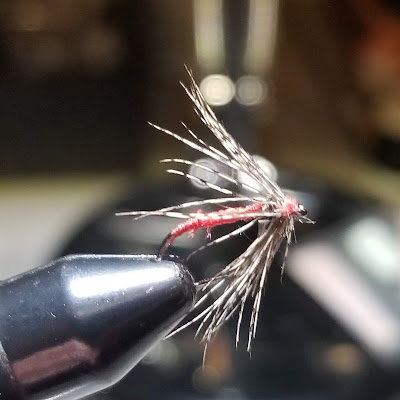"There's more bullshit in flyfishing than in a Texas cattle yard" - Lefty Kreh
Fly fishers like one or the other. I like one and that's poly wing yarn, the finer the better. I once was a big time user of CDC feathers on small dries but I've changed my ways for what I think are good reasons.Let's talk about those reasons and the history of CDC usage.
CDC is a loose translation for the French term Cul De Canard which basically means bottom of the duck. It first hit the fly tying stage back in the early 1980's and it was treated as a wonder material. Yes, it could float but it had some drawbacks:
1. It was said that these feathers resided near the preen oil gland of ducks and geese and were saturated with the stuff. One marketing genius tried to sell the preen oil as a floatant and totally failed because it was the structure of the feather that made it float, not the application of a floatant. That's why CDC flies sink if any liquid or gel comes in contact with it.
2. (Here's my favorite bogus reason for using CDC) - CDC works because it comes from harmless and benign waterfowl (ducks and geese) that pose no threat to a trout. Now, if that were true trout would have been beaching themselves to get away from the nymphs I used to make with raw, untanned MINK fur. (I wish I still had some). Years ago feathers from blue herons and kingfishers were tied into flies and they caught a lot of trout!!!
3. CDC is fragile stuff. It gets chewed up quickly which means your flies will have to be replaced.
A Better Way
1.Use Poly Wing Yarn. It's nonabsorbent (CDC isn't),
2. You can buy miles of it for next to nothing (not with CDC)
3. It's dainty and fine but tough as hell (tougher than CDC)
4. It comes in a zillion colors but you only need three
I can tie dries and emergers down to size 28 with this stuff without making them too top heavy. And after releasing a fish just wipe it with a paper towel (yes, a paper towel) and give it a shake with some silica powder and you're back on the battlefield.
A Word About Silica Powder
The stuff is great because it wicks away moisture and doesn't gum up the fly BUT the stuff that comes with a tiny applicator brush is a joke and here's why.
Most of these products are the "shaker" variety: dump the fly in the bottle, close the bottle, shake 2 or 3 times, open the bottle and fish. This works because the manufacturers of this product threw in "silica gel" along with the silica powder. The gel (tiny rocks) "moves" the powder around to coat the fly. Because the bottle top is closed during the application you do not lose any powder. This is a good idea!
Now, the guys with the applicator brush need the brush to get the powder on the fly and on everything else from hands, sleeves, waders to the surface of the water. One writer says don't use it in Montana because Montana is too windy!!! If silica gel was used you wouldn't need the brush. It was a bad idea!!
Keep fishing!!!!!
Ken




















